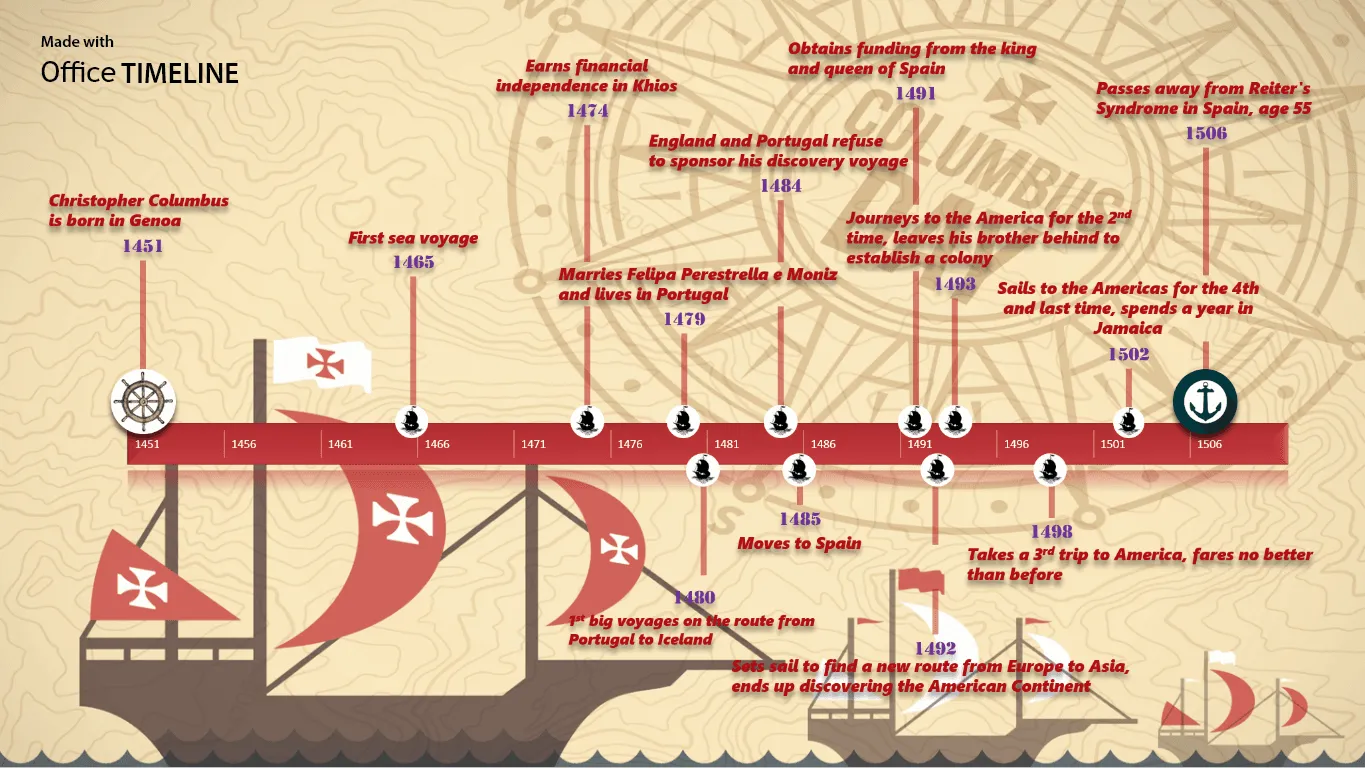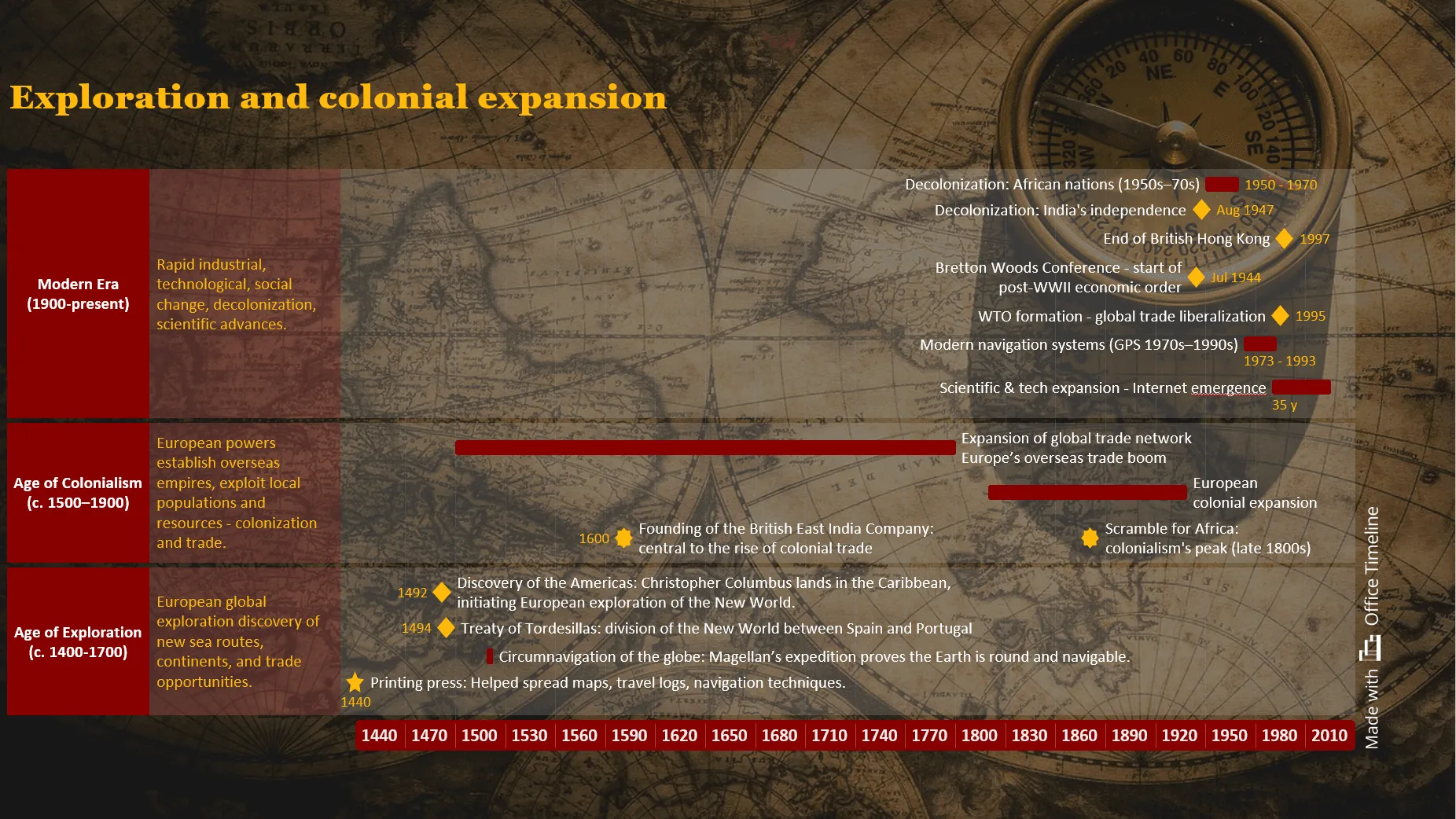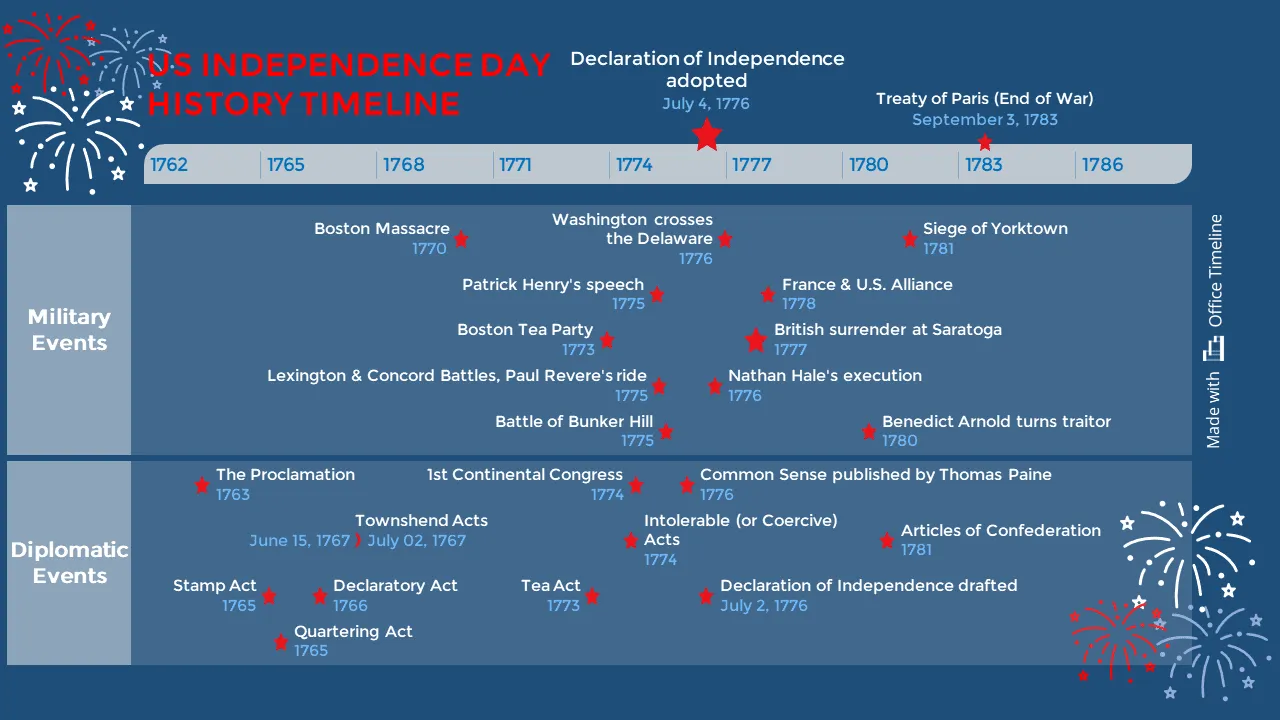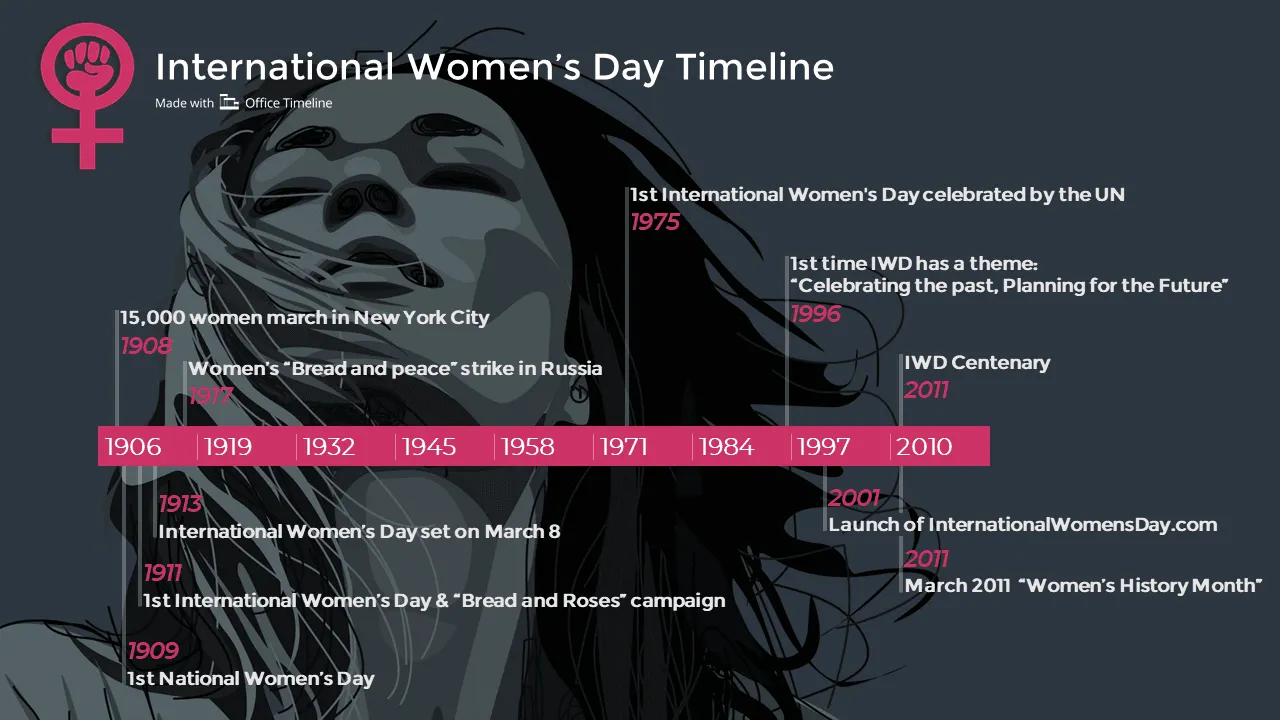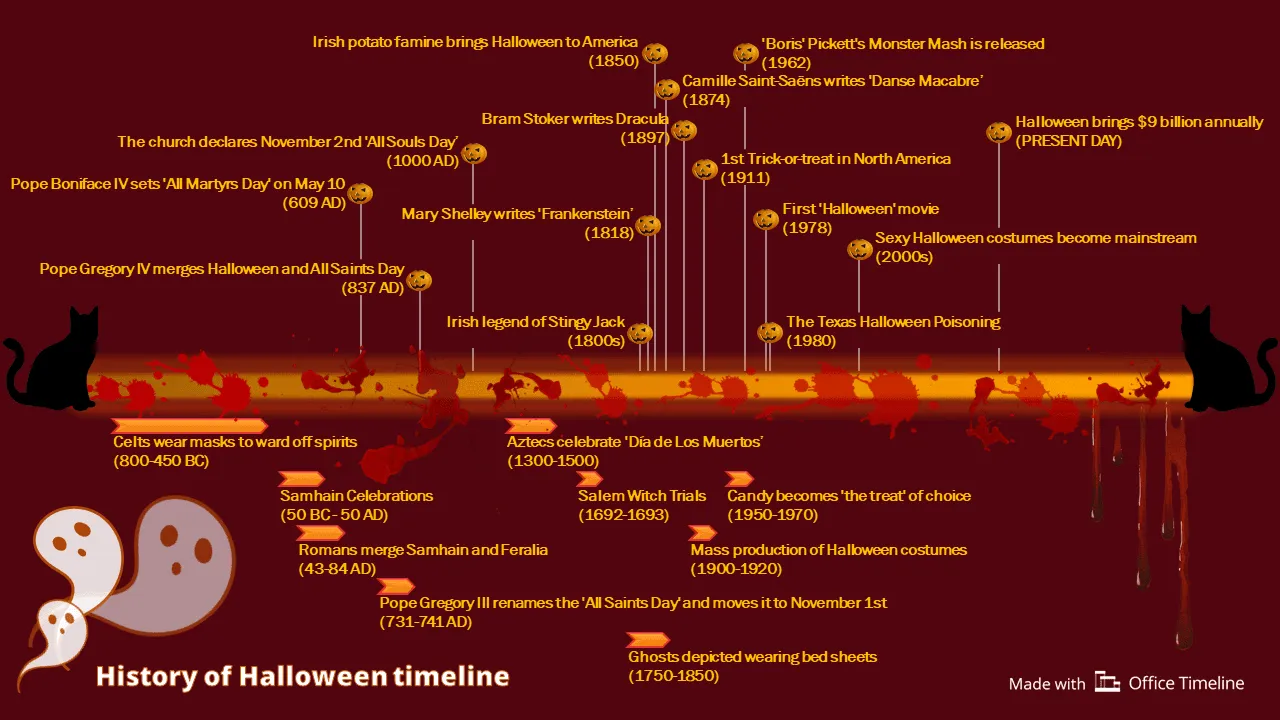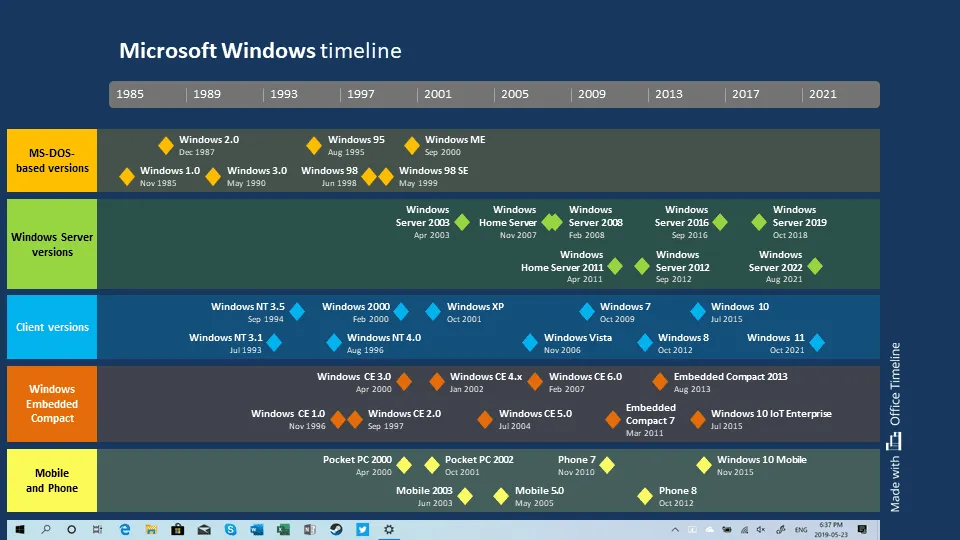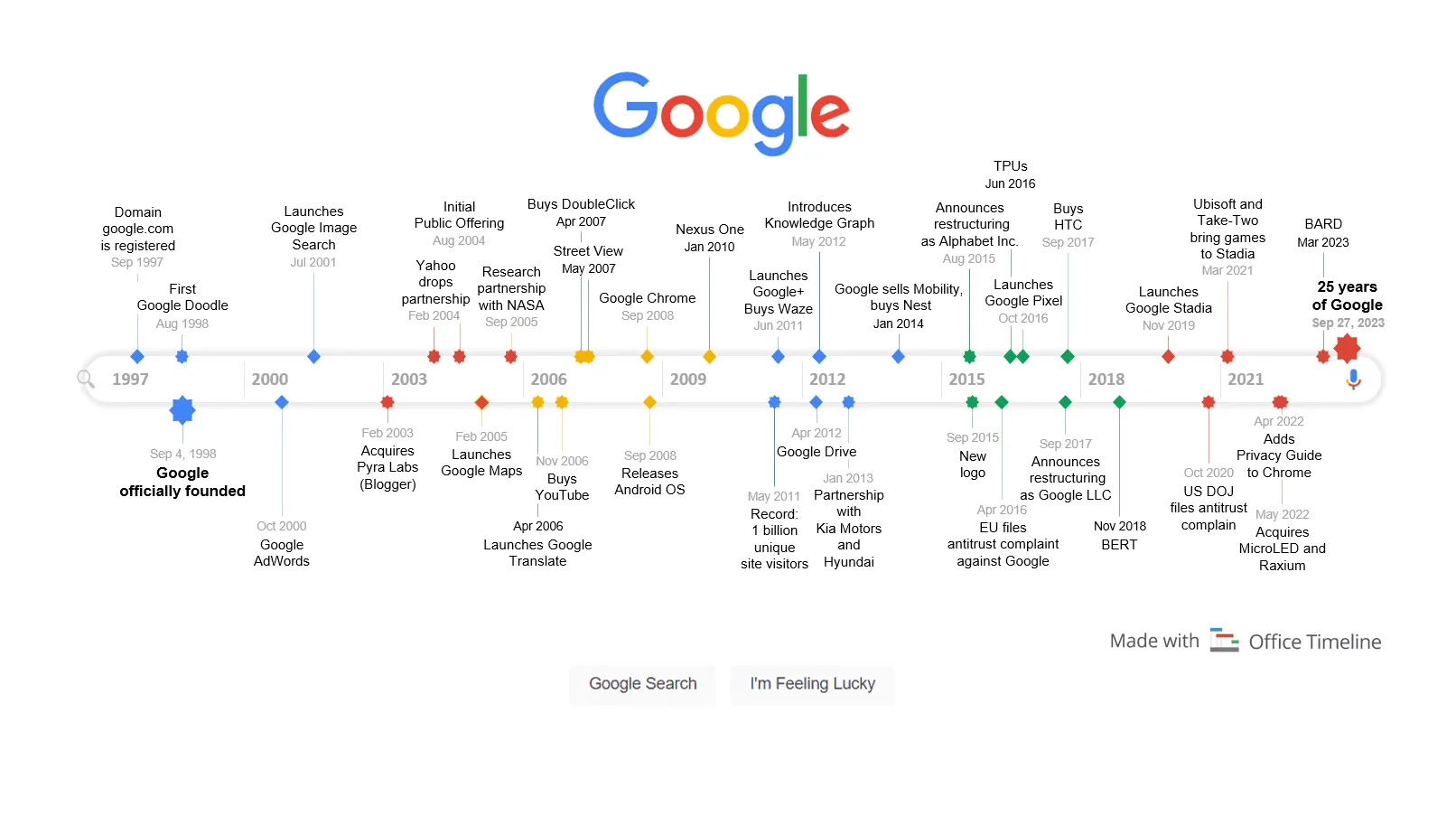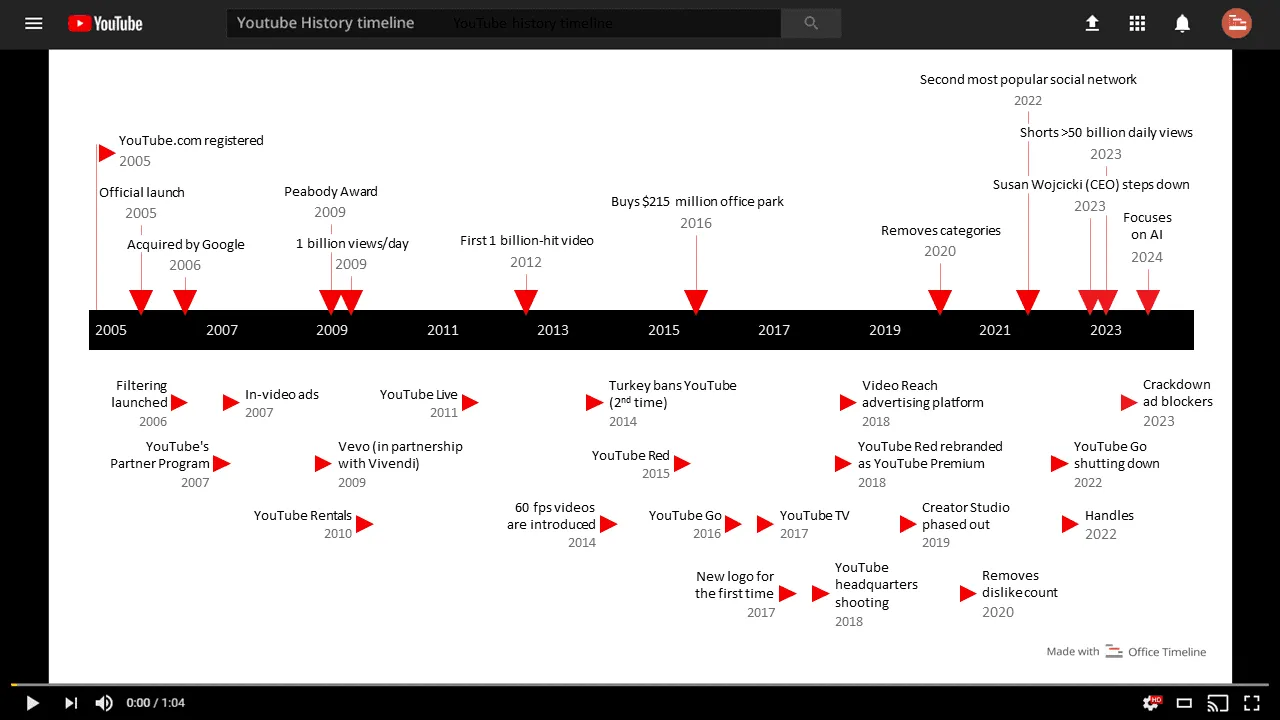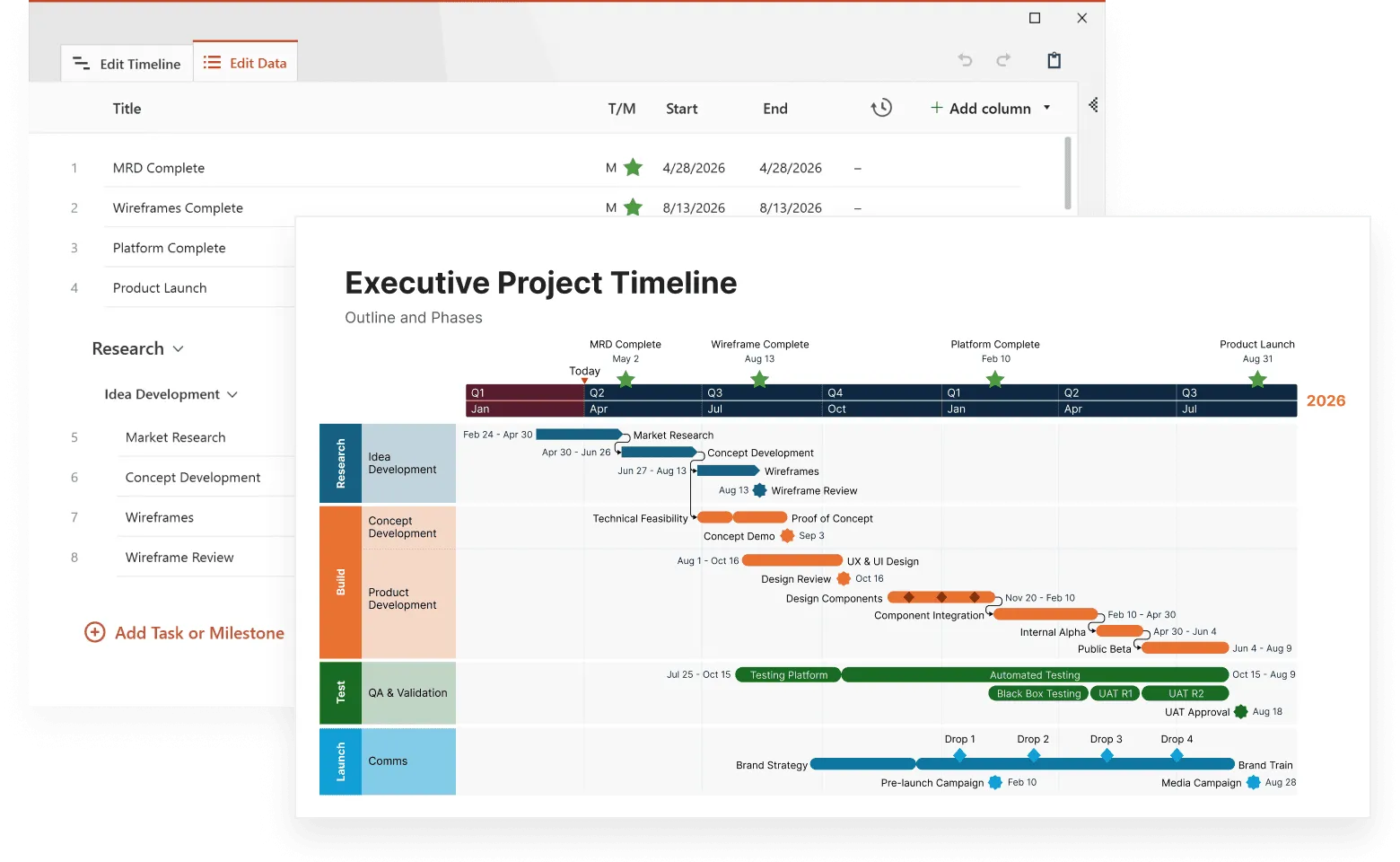History can feel like a jumble of names and dates until you lay it out on a timeline. By lining events up in order, timelines reveal the rhythm of change: revolutions that erupt almost overnight, discoveries that reshape the world in a single decade, and social progress that crawls forward over generations.
Timelines show us history as a web of connections, not only a list of facts. A protest sparks a law. A breakthrough in science becomes a weapon of war. A promise written on paper takes years before it changes real lives.
That power to reveal patterns and connections is what makes timelines so valuable, not only for understanding history, but also for planning projects, or tracking cultural change, as you can find out in our introduction to timelines.
The examples below capture turning points across centuries: the voyages of explorers and the birth of new nations, the evolution of cultural traditions and social movements, and the technological milestones that continue to shape our world.
Let’s look at some of the most famous timelines that captured turning points in history, moments that shaped the world we live in today and will continue to ripple through the future.
Classical history timelines
Classical history timelines often take us back to the age of exploration, when voyages like Columbus’s reshaped maps and sparked centuries of colonial expansion. They follow the rise of empires that stretched across oceans, and the struggles of colonies that eventually fought for their independence.
Through these timelines, we can see how discoveries, power, and resistance together shaped the beginnings of the modern world.
Christopher Columbus: opening the door to a new world
The voyages of Christopher Columbus mark one of history’s most famous turning points. They are often seen as the starting point of a new era.
In 1492, with the support of Spain, Columbus sailed west and reached the Caribbean. For Europe, this opened up new lands to explore and trade with. For the people already living there, it brought upheaval, disease, and the beginning of colonization.
Columbus returned to the Americas three more times between 1493 and 1504, exploring more islands and parts of Central and South America. On the timeline below, you can see how quickly one voyage turned into many, and how those journeys led other European countries to send their own expeditions across the ocean.
This timeline shows more than the travels of one man, it marks the beginning of a period when continents became connected in ways they never had before. Plants, animals, and goods were exchanged, but so were wars and forced migrations.
What started as a search for trade routes became the first step in the Age of Exploration and the centuries of expansion that followed.
Exploration and colonial expansion
Columbus’s voyages set off a wave of exploration that quickly turned into competition between European powers. The late 1400s and 1500s saw Spain and Portugal carving up new territories, followed by England, France, and the Netherlands. The Treaty of Tordesillas in 1494 even divided the world between Spain and Portugal on paper, though in practice, the rivalry spread across oceans.
Timelines of this era show how fast expansion happened. Within a century, Europeans had colonies in the Caribbean, South and North America, Africa, and Asia. Expeditions mapped coastlines, claimed land, and built trading posts.
The creation of companies like the British East India Company and the Dutch East India Company in the 1600s shows how exploration quickly tied into trade and profit.
But colonial expansion wasn’t only about maps and trade. It also brought forced labor, the spread of disease, and conflicts with local peoples whose lives were changed forever.
Looking at these events on a timeline makes clear how exploration, trade, and conquest were all linked, and how the expansion of empires shaped the world we live in today.
Independence Day: from protest to nationhood
As colonies grew stronger, tensions eventually rose between settlers and the empires that controlled them. Nowhere is this story clearer than in the timeline of American Independence. What we celebrate as the Fourth of July was not a single moment, but the result of years of protests, arguments, and war.
The trouble began in the 1760s, when Britain introduced new taxes like the Stamp Act and Townshend Acts without giving the colonies a say. Colonists responded with boycotts, protests, and groups such as the Sons of Liberty.
The conflict turned violent in 1770 with the Boston Massacre, and escalated further after the Boston Tea Party in 1773, which brought harsh punishment from Britain.
By 1775, open fighting had begun at Lexington and Concord. At first, many colonists still hoped for compromise, but ideas of independence spread quickly, especially after the publication of Thomas Paine’s “Common Sense” in 1776.
On July 4, 1776, the Declaration of Independence was adopted, though the war continued until 1783, when the Treaty of Paris finally recognized the United States as a new nation.
The Independence timeline shows that freedom is rarely gained overnight. It unfolds through long struggles, shifting ideas, and hard-won battles. What we remember as a holiday was in reality nearly two decades of change that transformed colonies into a country.
Bring clarity to historical timelines
Try Office Timeline for free. Create polished PowerPoint timelines that make major historical events, eras, and cultural shifts easy to understand at a glance.
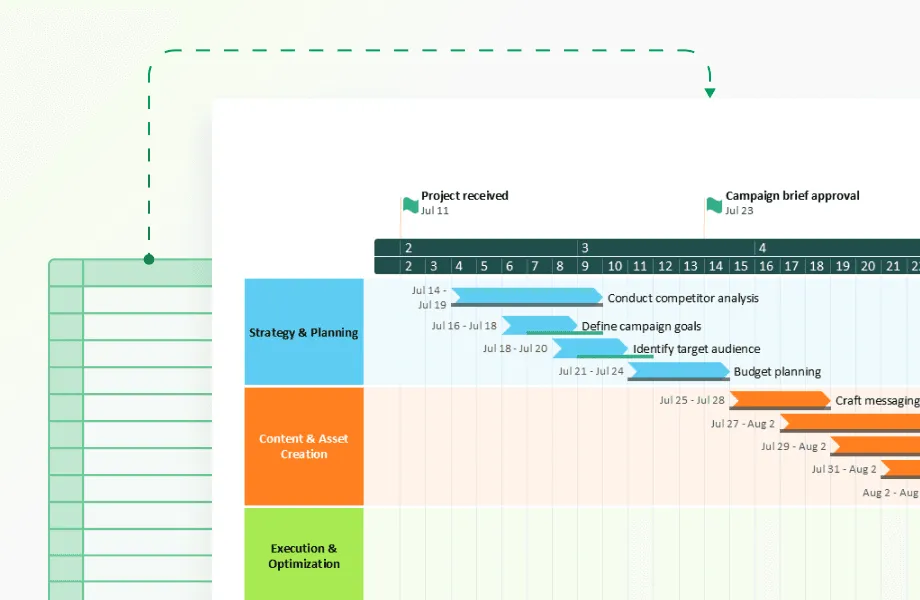
Cultural and commemorative timelines
History is not all about wars and politics. It also lives in the traditions, celebrations, and social movements that shape how people see themselves and their communities.
Cultural and commemorative timelines show us how holidays and observances change over time, often blending old customs with new meanings, and also how ideas and practices evolve, spread, and sometimes change form completely over centuries.
International Women’s Day
The story of International Women’s Day began in the early 1900s, when women marched for better working conditions and the right to vote. In 1909, American socialists organized the first National Woman’s Day in New York. A year later, at a conference in Copenhagen, activists called for an annual day of action.
The first International Women’s Day was held in 1911, with demonstrations across Europe. In 1917, women in Russia went on strike for “bread and peace,” an action that helped spark the Russian Revolution, and just days later, women gained the right to vote there. March 8 became the official date, later recognized by the United Nations in 1975.
Today, the timeline continues, with International Women’s Day celebrated worldwide. In some places it’s a day of appreciation, in others a day of protest, but everywhere it marks over a century of struggle for equality.
Halloween: a tradition transformed
The Halloween timeline shows how a seasonal festival turned into a modern celebration. It began as Samhain, a Celtic festival marking the end of harvest and the start of winter, when people lit bonfires and wore costumes to ward off spirits.
Over centuries, Samhain blended with Roman and Christian traditions, becoming All Hallows’ Eve. Immigrants brought these customs to America in the 1800s, where Halloween gradually shifted into a community holiday with parties, costumes, and games.
By the mid-20th century, trick-or-treating was widespread, and by the 21st century, Halloween had grown into a major cultural and commercial event.
Seeing Halloween’s history on a timeline makes it clear how traditions evolve. What began as rituals to mark the changing seasons is now one of the world’s most recognizable, and profitable, festivals.
These two examples highlight how timelines explain political history, and also show how traditions and cultural expressions change, adapt, and endure.
Technology and innovation timelines
Some timelines span centuries, showing slow shifts in empires, cultures, and traditions. Others unfold in only a few decades, yet their impact is just as profound.
The history of modern technology is a striking example, where a single idea can spread worldwide in a short time and completely reshape how we live, work, and communicate. Seeing these stories laid out on a timeline makes the speed and scale of that change impossible to miss.
Windows: bringing computers to the masses
When Microsoft released the first version of Windows in 1985, computers were still complicated tools used mostly by businesses. Windows introduced a more user-friendly interface that made computers accessible to ordinary people.
Key releases, like Windows 95, which popularized the Start menu, or Windows XP, which became one of the most widely used operating systems, show how the platform evolved alongside the growth of personal and workplace computing.
Today, Windows continues to adapt in a world where laptops, tablets, and cloud services are everywhere.
Google: from search engine to global giant
In 1998, two students launched Google as a search engine designed to make sense of the growing internet. Its timeline tells a story of rapid growth: within just a few years, Google expanded into maps, email, online advertising, and later smartphones and artificial intelligence.
What began as a tool to find websites is now a company that touches nearly every corner of digital life. The Google timeline makes clear how quickly technology can move from niche innovation to global infrastructure.
YouTube: the era of online video
The YouTube timeline starts in 2005, when three former PayPal employees created a simple site for sharing videos. Early viral clips made it popular, but its growth was explosive after Google acquired it in 2006.
In less than two decades, YouTube has become the world’s largest video platform and one of the most influential cultural spaces on the planet.
From entertainment and education to politics and activism, its timeline shows how a small startup reshaped how billions of people watch, learn, and share content.
Together, these timelines show how technology can transform the world in a fraction of the time once needed for political or cultural change. What took centuries for empires or traditions to develop, digital innovation has achieved in just a few decades.
Fast forward to today, and we can see how these shifts have reshaped how we learn, work, and connect on a global scale. Placed alongside history’s longer timelines, they highlight how the pace of change has accelerated, and why mapping these moments matters more than ever.
Create clearer timelines effortlessly
Try Office Timeline for free. Turn complex events, milestones, and stories into clean, presentation-ready timeline slides in minutes.
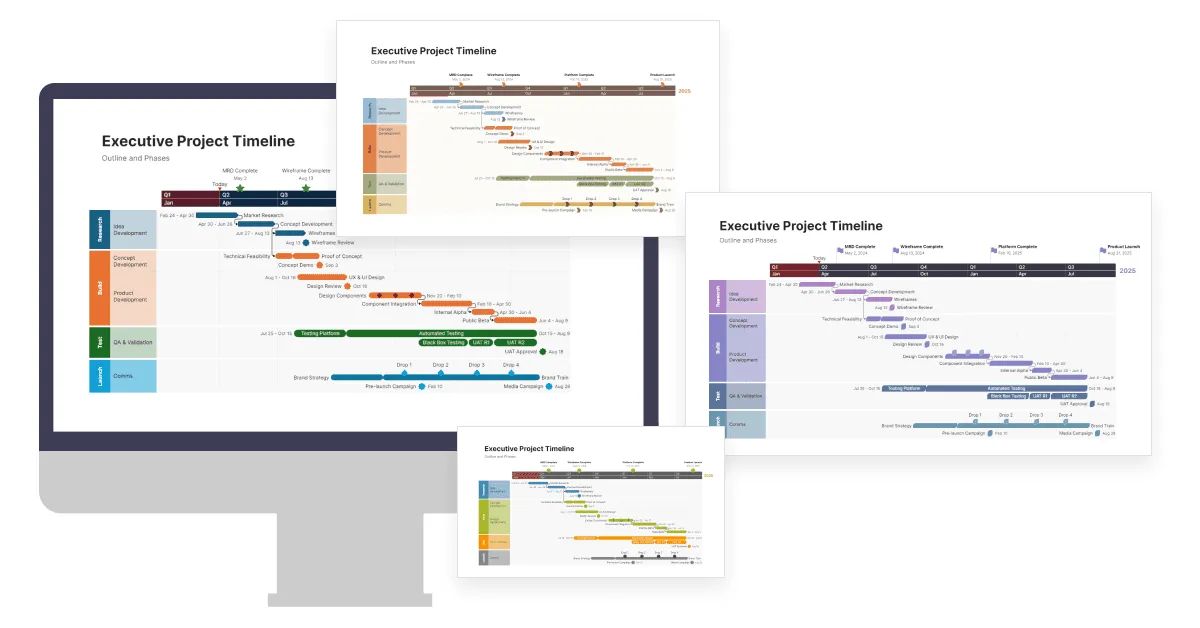
Conclusion
Timelines remind us that history moves at different speeds. Some stretch across centuries, like the rise and fall of empires or the slow evolution of cultural traditions. Others unfold in just a few decades, like the growth of Google or YouTube, yet their influence can be just as far-reaching.
By laying events side by side, timelines make these differences clear. They show how exploration led to expansion and eventually independence, how festivals and movements changed meaning over time, and how technology leapt from small beginnings to global transformation.
What makes timelines so powerful is their ability to connect these stories, whether centuries long or only a few years, and reveal the patterns that shaped our past and continue to shape our present.
In seeing history this way, we gain not only perspective on where we came from, but also insight into how today’s moments may become tomorrow’s milestones.
Historical timelines FAQ
Creating timelines for historical periods presents challenges that differ from business or project timelines. Historical data often spans centuries, contains uncertain dates, and requires contextualizing events across different civilizations.
These questions address common issues when visualizing historical information through timelines.
Timelines provide context. They allow you to see what happened before and after, to compare developments across regions, and to trace how causes link to consequences. This helps turn disconnected facts into stories.
Historical uncertainty is tricky! For events like "the founding of Rome" or early Egyptian dynasties, be transparent about approximations. I like using "c." (circa) before estimated dates and slightly faded or dotted borders around less certain events. For interactive timelines, you can add hover notes explaining the evidence behind the dating. Most importantly, be consistent in how you represent uncertainty so your viewers understand your visual language.
Focus on turning points rather than listing every event. Ask yourself:
- Which events actually changed the course of history?
- What patterns would be impossible to see without this particular event?
- Which figures or developments best represent entire eras?
For Ancient Egypt, you might show the Old, Middle and New Kingdoms as continuous bands, then highlight just key events like the building of the Great Pyramid, Hatshepsut's reign, and Akhenaten's religious revolution. This creates a cleaner visual story while preserving the essential narrative. Think of your timeline as telling a story - not every detail belongs in the summary
Historians don’t try to capture every event. Timelines work best when they highlight milestones that shaped the bigger story. They look for events that are defining, representative, and well-documented.
A good timeline also balances local details with the larger picture. For example, a protest in one city might seem small, but if it sparked a national movement, it belongs on the timeline. By connecting individual moments to wider political, cultural, or technological shifts, historians create timelines that are not only accurate but also meaningful and easy to follow.
Yes. By laying many events side by side, you can spot cycles (war, reform, conflict), see accelerations or slowdowns in progress, and detect relationships that aren’t obvious when looking at events in isolation.
Building a timeline involves choices and trade-offs. You can’t include every event, so the challenge is to decide what to highlight, how much detail to show, and which perspective to emphasize. The goal is to create something that’s both accurate and easy to follow without overwhelming the reader.
Some common challenges include:
- Conflicting sources. Different records may give different dates or details.
- Event selection. Deciding which moments are essential and which to leave out.
- Time scale. Choosing whether to show centuries, decades, or years.
- Clarity vs. nuance. Simplifying complex events without distorting them.
- Local vs. global impact. Showing how small events connect to wider changes.
A good timeline balances accuracy with readability. It gives a clear picture while keeping the bigger story intact.


